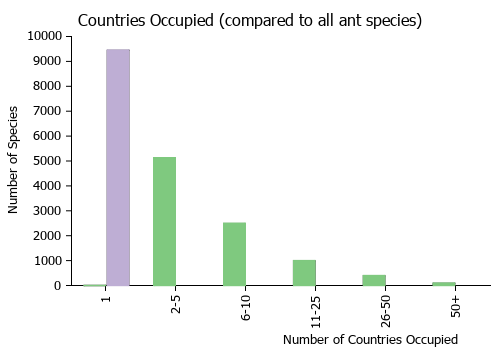Strumigenys agnosta
| Strumigenys agnosta | |
|---|---|

| |
| Scientific classification | |
| Kingdom: | Animalia |
| Phylum: | Arthropoda |
| Class: | Insecta |
| Order: | Hymenoptera |
| Family: | Formicidae |
| Subfamily: | Myrmicinae |
| Tribe: | Attini |
| Genus: | Strumigenys |
| Species: | S. agnosta |
| Binomial name | |
| Strumigenys agnosta (Bolton, 2000) | |
Nothing is known about the biology of Strumigenys agnosta.
Identification
A member of the Strumigenys baudueri-group.
Keys including this Species
Distribution
Latitudinal Distribution Pattern
Latitudinal Range: -22.875° to -22.875°.
| North Temperate |
North Subtropical |
Tropical | South Subtropical |
South Temperate |
- Source: AntMaps
Distribution based on Regional Taxon Lists
Afrotropical Region: South Africa (type locality).
Distribution based on AntMaps
Distribution based on AntWeb specimens
Check data from AntWeb
Countries Occupied
| Number of countries occupied by this species based on AntWiki Regional Taxon Lists. In general, fewer countries occupied indicates a narrower range, while more countries indicates a more widespread species. |

|
Estimated Abundance
| Relative abundance based on number of AntMaps records per species (this species within the purple bar). Fewer records (to the left) indicates a less abundant/encountered species while more records (to the right) indicates more abundant/encountered species. |

|
Biology
Castes
Nomenclature
The following information is derived from Barry Bolton's Online Catalogue of the Ants of the World.
- agnosta. Pyramica agnosta Bolton, 2000: 293, figs. 199, 227 (w.) SOUTH AFRICA. Combination in Strumigenys: Baroni Urbani & De Andrade, 2007: 115
Unless otherwise noted the text for the remainder of this section is reported from the publication that includes the original description.
Description
Worker
Holotype. TL 2.0, HL 0.51, HW 0.34, CI 67, ML 0.07, MI 14, SL 0.27, SI 79, PW 0.24, AL 0.52. Answering the description given for Strumigenys dictynna, to which it is closely related; the two are separated by the following distinguishing characters.
S. agnosta: Spatulate hairs on disc of clypeus fine and indistinct. Occipital lobe without a laterally projecting flagellate hair in full-face view. Cephalic dorsum close to occipital margin with a single pair of fine erect hairs that are situated close to the midline. Hairs on first gastral tergite restricted to a basal and an apical transverse row, the central band of the sclerite hairless. Dorsal length of petiolar peduncle about equal to the height of the anterior face of the node in profile.
S. dictynna: Spatulate hairs on disc of clypeus broad and conspicuous. Occipital lobe with a laterally proj ecting flagellate hair in full-face view. Cephalic dorsum close to occipital margin with a pair of erect hairs close to the midline, and a second pair close to the occipital corners that are directed dorsolaterally. Hairs on first gastral tergite distributed over the sclerite, without a broad hairless central band. Dorsal length of petiolar peduncle greater than height of the anterior face of the node in profile.
Paratypes. TL 1.9-2.0, HL 0.47-0.51, HW 0.33-0.34, CI 66-72, ML 0.07, MI 14-16, SL 0.25-0.27, SI 74-79, PW 0.22-0.25, AL 0.50-0.52 (7 measured).
Type Material
Holotype worker, South Africa: Transvaal, Soutpansberg E, 15.iii.1973, E-Y 58, sifting (S. Endrody-Younga) (Transvaal Museum).
Paratypes. 1 1 workers with same data as holotype (TVM, South African Museum, The Natural History Museum, Museum of Comparative Zoology).
References
- Baroni Urbani, C. & De Andrade, M.L. 2007. The ant tribe Dacetini: limits and constituent genera, with descriptions of new species. Annali del Museo Civico di Storia Naturale “G. Doria”. 99:1-191.
- Bolton, B. 2000. The ant tribe Dacetini. Memoirs of the American Entomological Institute. 65:1-1028. (page 293, figs. 199, 227 worker described)
References based on Global Ant Biodiversity Informatics
- Bolton, B. 2000. The Ant Tribe Dacetini. Memoirs of the American Entomological Institute 65

